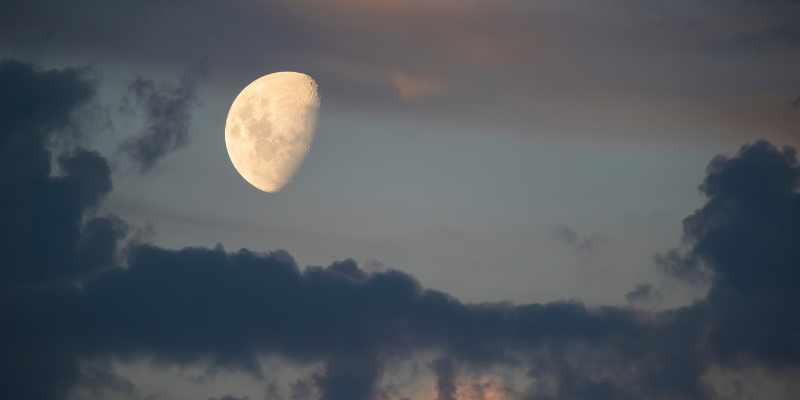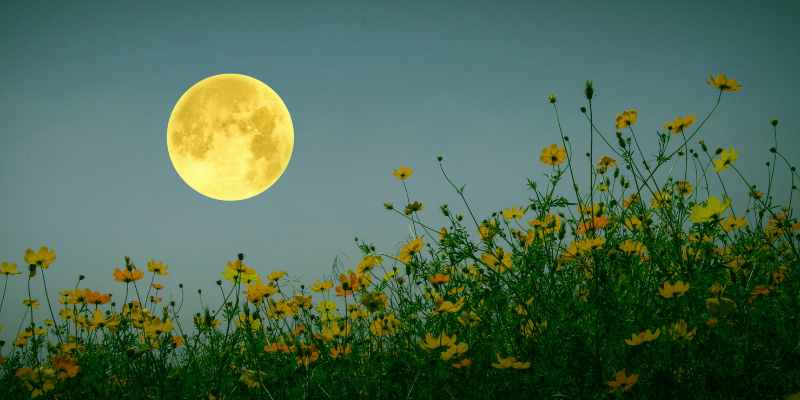The moon, a celestial body of all fantasies, has long been the subject of debate regarding its effects on plants. There are those who swear by lunar calendars for sowing, planting, pruning, or mowing the lawn, and those who do not believe in it at all. We know the effects of the moon on our good old planet Earth, particularly its attraction on ocean tides. It is even said to have some effects on humans, their sleep, or moods… but does it really affect our gardens, and if so, to what extent? The most reputable magazines include a lunar calendar in their pages, so… fact or fiction, myth or reality?
I wanted to get to the bottom of it and find out once and for all if the moon truly exerts a real influence on plants. To do this, I carried out sowings and plantings on very different days to draw my own conclusions. Curious about the results? Here they are!

What do the moon's movements in the sky tell us?
Let’s start at the beginning, with what books or popular belief tell us about the rotation and gravitational pull of the moon, and what is scientifically proven. While the moon is subject to controversy, it remains a fact that our only satellite moves in the sky. The fundamental principle of gardening in tune with the moon is based on its position in the sky.
However, it can be confusing to distinguish between the waxing or ascending moon and other subtleties, and it is essential to understand three distinct factors:
The phases of the moon
Easy to spot with the naked eye, we can identify four main phases of the Moon (actually eight if we count the intermediate crescents), marked by the four quarters of the Moon. These phases are due to the relative positions of the Moon-Earth-Sun axis, which determines the portion of the Moon illuminated by the Sun as seen from Earth: the new moon, when it is not illuminated at all by the Sun, becoming almost invisible; the first quarter, in the shape of a crescent open to the left; the full moon, when it is completely illuminated by the Sun; and the last quarter of the moon, where it forms a crescent open to the right, before disappearing completely to restart the lunar cycle with the new moon. This lunar cycle lasts about 29.5 days.
These phases inform what is referred to as the waxing and waning moon in "lunar" language:
- Waxing moon: the period when the illuminated part of the moon we see increases, from the new moon to the full moon;
- Waning moon: the period when the illuminated part of the moon decreases: from the full moon to the new moon.
Scientifically speaking, we can assert that these phases influence the amount of nocturnal moonlight. Some gardeners believe that this increased light during the waxing moon stimulates the growth of the aerial parts of plants, while the diminishing light is favourable for root growth. To date, however, no scientific study has proven this.
The position of the Moon relative to the Earth: perigee and apogee
The Moon orbits the Earth in an elliptical path, meaning its distance from our planet varies. When it is closest to the Earth (about 357,000 km), it is referred to as perigee, and when it is farthest away (an additional 50,000 km or so), it is called apogee.
These variations in distance could influence the gravitational force exerted by the Moon on the Earth, and thus on plants, but certainly to a minimal extent… In the case of high tides, for example, there is a clear link with the phases of the full moon or new moon, and not with perigee or apogee. Note: perigee is considered detrimental in lunar gardening.
The ascending and descending movement of the Moon on the horizon
The ascending and descending movements of the Moon are due to its tilted orbit around the Earth. This time, we refer to what is called the tropical rhythm of the moon: the height of the lunar trajectory relative to the celestial equator differs. The human eye can distinguish this over several days, observing that the moon is higher or lower on the horizon.
These phases inform what is referred to as the ascending and descending moon:
- Ascending or rising moon: the period when the position of the Moon in the sky is higher each day compared to the horizon.
- Descending moon: the period when the Moon appears to descend lower in the sky each night.
The ascending moon, associated with rising sap, is said to be favourable for sowing, harvesting, and grafting, while the stronger growth during the descending moon, associated with descending sap, is said to be favourable for roots, soil work, planting, transplanting, and pruning.
Some see a correlation with zodiac constellations.
Some even see a link here with the moon's trajectory in front of the twelve zodiac constellations (where, from Gemini—the highest constellation—to Scorpio, the moon is descending), and attribute to each of the four elements related to the zodiac a correlation with flower days (air), leaf days (water), fruit days (fire), and root days (earth). Each type of day is thus said to favour the growth of a specific part of plants.
Again, there is no irrefutable proof, but biodynamics refers to this in its guidelines as a planning tool.

My Experience with the Moon
On my part, I admit that before starting my little experiment, I had no preconceived notions. The Moon is a fascinating celestial body for me, particularly for its influence on tides and the luminous power it exerts when it approaches a perfect circle. However, I had not really delved into the subject, despite years of gardening experience. To avoid any influence, I carried out sowings, plantings, and cuttings at times that suited me, without consulting any calendar, but carefully noting all my actions in a small notebook for future reference.
What interested me most was to find out whether it was more beneficial to plant or sow during supposedly favourable lunar phases, or not.
I therefore carried out several sowings in spring, including several annual ornamental flowers (sweet peas, daisies, balsam, and poppies) and a few vegetables (lettuce, parsley, coriander, and Swiss chard). During this same period, I planted some perennials (lobelias, hostas, epimediums…) while meticulously noting the intervention dates. I then transplanted the same plants at different times to see if it affected their ability to thrive. Finally, to complete this little lunar test, I conducted a hydrangea cutting test this summer.
In terms of sowings, I encountered issues with a few flowers at the beginning, due to my sense of the bad weather in March or the poor quality of the seeds, as some sowings did not take at all, like an initial batch of sweet peas.
This summer, as my various trials bore fruit (finally… their flowers), I consulted an online lunar calendar to find out when in the lunar calendar I had sown or planted, and I evaluated the success rate of each of my trials. I simply checked in detail my blind tests: whether the moon was ascending or descending, waxing or waning, and what type of day it was (fruit, root, leaf, or flower).
The verdict? Well… no lunar miracle on my part… my plants thrived regardless of the lunar phase, except for one failed sowing at the beginning, regardless of whether the moon was ascending, waxing, or not. Unfortunately, none of my blind sowings and plantings coincided with a "lunar node," so I cannot comment on that. Almost a disappointment, as all this was starting to intrigue me and make me want to believe…
And its influence on the weather?
The moon has often been mentioned in popular sayings associating it with weather forecasts, which were the only possible ones for centuries, alongside cloud observation or animal behaviour, in a time not so long ago without screens!
Here are a few of the least far-fetched sayings I found. Do they hold true?
"Cut your hay: when the moon comes into the water, in three days it will be fine"
"Ringed moon, rain assured"
"When the moon has its ring, water will fall"
or "Pale moon in the evening, in the morning it will rain well".
This is another topic for discussion, which I invite you to continue here, based on your own observations of the sky…
So, are you tempted to plan your gardening tasks using a lunar calendar or not? If we must consider the weather and the whims of the moon, one might say we can no longer garden. Ultimately, everyone has their own method, as long as we enjoy gardening, right? But sharing experiences in this area is always interesting. Please feel free to share your trials and experiences with us!
I’ll leave the final word to Olivier de Serres, who claimed in the 16th century "that man, being too lunar [consulting the moon], does not fill his basket with fruits"...































Comments